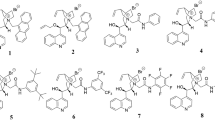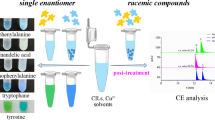Abstract
The charge neutral chiral optical sensors 1a∼d containing thiourea and amide groups were synthesized by simple steps in good yields and their structures were characterized by IR, 1H NMR, 13C NMR, MS spectra and elemental analysis. The enantioselective recognition for α-phenylglycine and phenylglycinol was examined by fluorescence emission and UV-vis spectra. The fluorescence and UV-vis spectra changes of 1a were obvious when the enantiomers of α-phenylglycine anion were added, which exhibited that 1a has good enantioselective recognition ability towards α-phenylglycine.









Similar content being viewed by others
References
de Silva AP, McCoy CP, Rademacher JT, Rice TE (1997) Signaling recognition events with fluorescent sensors and switches. Chem Rev 97:1515–1566
Collins AN, Sheldrake GN, Crosby J (1997) Chirality in industry. Wiley, Chichester
Martinez-Manez R, Sancenon F (2003) Fluorogenic and chromogenic chemosensors and reagents for anions. Chem Rev 103:4419–4476
Zhao JZ, Davidson MG, Mahon MF, Kociok-Kohn G, James TD (2004) An enantioselective fluorescent sensor for sugar acids. J Am Chem Soc 126:16179–16186
Zhang XX, Bradshaw JS, Izatt RM (1997) Enantiomeric recognition of amine compounds by chiral macrocyclic receptors. Chem Rev 97:3313–3361
Kim KS, Kim BH, Park WM, Cho SJ (1993) Origin of diastereoselectivity in the nitrile oxide cycloadditions with Oppolzer’s chiral sultams: coulombic interaction as the key role in diastereofacial differentiation. J Am Chem Soc 115:7472–7477
Famulok M, Szostak JW (1992) Stereospecific recognition of tryptophan agarose by in vitro selected RNA. J Am Chem Soc 114:3990–3991
Fitzmaurice RJ, Kyne GM, Douheret D, Kilburn JD (2002) Synthetic receptors for carboxylic acids and carboxylates. J Chem Soc, Perkin Trans 1:841–864
You JS, Yu XQ, Zhang GL, Xiang QX, Lan JB, Xie RG (2001) Novel chiral imidazole cyclophane receptors: synthesis and enantioselective recognition for amino acid derivatives. Chem Commun 2001:1816–1817
Li ZB, Lin J, Zhang HC, Sabat M, Hyacinth M, Pu L (2004) Macrocyclic bisbinaphthyl fluorophores and their acyclic analogues: signal amplification and chiral recognition. J Org Chem 69:6284–6293
Yakovenko AV, Boyko VI, Kalchenko VI, Baldini L, Casnati A, Sansone F, Ungaro R (2007) N-linked peptidocalix[4]arene bisureas as enantioselective receptors for amino acid derivatives. J Org Chem 72:3223–3231
Pu L (2004) Fluorescence of organic molecules in chiral recognition. Chem Rev 104:1687–1716
Martinez-Manez R, Sancenon F (2005) New advances in fluorogenic anion chemosensors. J Fluoresc 15:267–285
Gunnlaugsson T, Ali HDP, Glynn M, Kruger PE, Hussey GM, Pfeffer FM, Santos CMG, Tierney J (2005) Fluorescent photoinduced electron transfer (PET) sensors for anions; from design to potential application. J Fluoresc 15:287–299
Gunnlaugsson T, Davis AP, Glynn M (2001) Fluorescent photoinduced electron transfer (PET) sensing of anions using charge neutral chemosensors. Chem Commun 2001:2556–2557
Bhattacharyya T, Nilsson UJ (2001) An efficient and convergent route towards water-soluble, chiral and amphiphilic macrocycles. Tetrahedron Lett 42:2873–2875
Narumi F, Hattori T, Matsumura N, Onodera T, Katagiri H, Kabuto C, Kameyama H, Miyano S (2004) Synthesis of an inherently chiral O,O’-bridged thiacalix[4] crown carboxylic acid and its application to a chiral solvating agent. Tetrahedron 60:7827–7833
Sessler JL, Cho DG, Lynch V (2006) Diindolylquinoxalines: effective indole-based receptors for phosphate anion. J Am Chem Soc 128:16518–16519
Pfeffer FM, Lim KF, Sedgwick KJ (2007) Indole as a scaffold for anion recognition. Org Biomol Chem 5:1795–1799
Gunnlaugsson T, Davis AP, O'Brien JE, Glynn M (2005) Synthesis and photophysical evaluation of charge neutral thiourea or urea based fluorescent PET sensors for bis-carboxylates and pyrophosphate. Org Biomol Chem 3:48–56
Kubo Y, Tsukahara M, Ishihara S, Tokita S (2000) A simple anion chemosensor based on a naphthalene-thiouronium dyad. Chem Commun 2000:653–654
Kubo Y, Ishihara S, Tsukahara M, Tokita S (2002) Isothiouronium-derived simple fluorescent chemosensors of anions. J Chem Soc Perkin Trans 2:1455–1460
Xu KX, Wu XJ, He YB, Liu SY, Qing GY, Meng LZ (2005) Synthesis and chiral recognition of novel chiral fluorescence receptors bearing 9-anthryl moieties. Tetrahedron Asymmetry 16:833–839
Nishizawa S, Kato R, Hayashita T, Teramae N (1998) Anion sensing by a thiourea based chromoionophore via hydrogen bonding. Anal Sci 14:595–597
Huang XH, He YB, Chen ZH, Hu CG, Qing GY (2008) Novel chiral fluorescent chemosensors for malate and acidic amino acids based on two-arm thiourea and amide. Can J Chem 86:170–176
Braun D, Rettig W, Delmond S, Letard JF, Lapouyade R (1997) Amide derivatives of DMABN: a new class of dual fluorescent compounds. J Phys Chem A 101:6836–6841
Malval JP, Lapouyade R (2001) Derivatization of 4-(dimethylamino)benzamide to dual fluorescent ionophores: divergent spectroscopic effects dependent on N or O amide chelation. Helv Chim Acta 84:2439–2451
Schneider HJ, Yatsimirsky AK (2000) Principles and methods in supramolecular chemistry. Wiley, New York
Valeur B, Pouget J, Bourson J, Kaschke M, Ernsting NP (1992) Tuning of photoinduced energy transfer in a bichromophoric coumarin supermolecule by cation binding. J Phys Chem 96:6545–6549
Acknowledgments
We thank the National Natural Science Foundation for financial support (Grant No. 20572080).
Author information
Authors and Affiliations
Corresponding author
Electronic supplementary material
Below is the link to the electronic supplementary material.
Fig. S1
a Fluorescence spectra of receptor 1a (5 × 10−5 mol L−1) with l-Phol in DMSO. b Fluorescence spectra of receptor 1a (5 × 10−5 mol L−1) with d-Phol in DMSO. (DOC 126 kb)
Fig. S2
a Fluorescence spectra of receptor 1b (5 × 10−5 mol L−1) with l-Phol in DMSO. b Fluorescence spectra of receptor 1b (5 × 10−5 mol L−1) with d-Phol in DMSO. (DOC 147 kb)
Fig. S3
a Fluorescence spectra of receptor 1c (5 × 10−5 mol L−1) with l-Phe in DMSO. b Fluorescence spectra of receptor 1c (5 × 10−5 mol L−1) with d-Phe in DMSO. (DOC 106 kb)
Fig. S4
a Fluorescence spectra of receptor 1c (5×10−5 mol L−1) with l-Phol in DMSO. b Fluorescence spectra of receptor 1c (5 × 10−5 mol L−1) with d-Phol in DMSO. (DOC 124 kb)
Fig. S5
a Fluorescence spectra of receptor 1d (5 × 10−5 mol L−1) with l-Phe in DMSO. b Fluorescence spectra of receptor 1d (5 × 10−5 mol L−1) with d-Phe in DMSO. (DOC 112 kb)
Fig. S6
a UV–vis absorption spectra of receptor 1b (5 × 10−5 mol L−1) with l-Phe in DMSO. b UV–vis absorption spectra of receptor 1b (5 × 10−5 mol L−1) with d-Phe in DMSO. (DOC 70.5 kb)
Rights and permissions
About this article
Cite this article
Huang, XH., He, YB., Hu, CG. et al. Synthesis and Chiral Recognition Properties of Novel Fluorescent Chemosensors for Amino Acid. J Fluoresc 19, 97–104 (2009). https://doi.org/10.1007/s10895-008-0385-3
Received:
Accepted:
Published:
Issue Date:
DOI: https://doi.org/10.1007/s10895-008-0385-3




